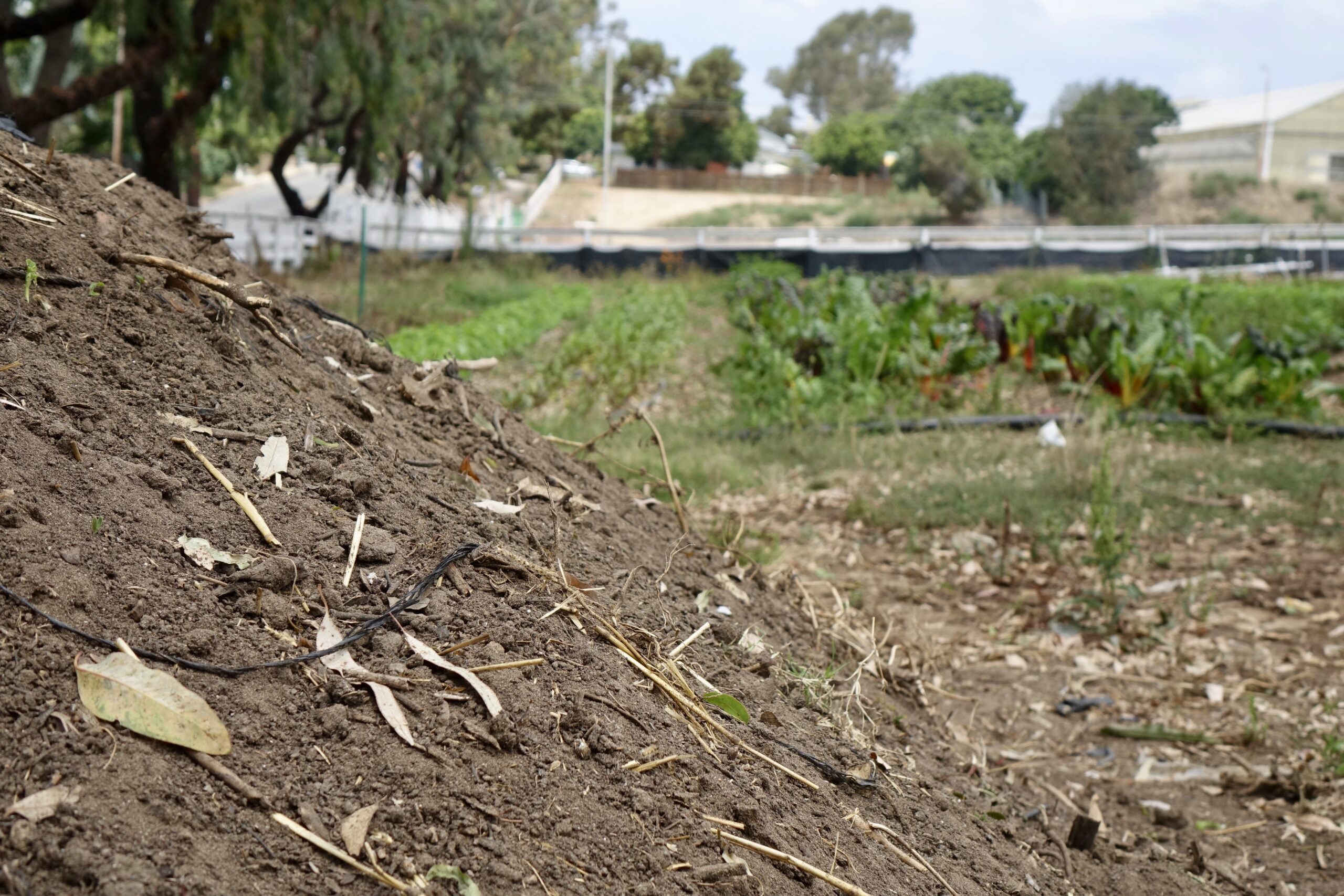We’re back with the next installment of Everything You Need to Know. In this series, we explore different terms and techniques used at Coastal Roots Farm. If you’re not sure what biodynamic farming means, or if you’re curious about the history behind Jewish agricultural practices, stay tuned. (Got a topic you’d like to see covered? Leave a comment below!)
Next up in our series: Compost! For this topic we turned to experts on the Farm: Compost Coordinator Ellie Honan and Daron “Farmer D” Joffe. Farmer D’s book Citizen Farmers contains sage, practical advice for turning your dirt into nutrient-rich soil, whether you’re a home gardener or a full-time farmer.
Kombucha for Soil
Composting is the process of turning organic waste into nutrient-rich compost, which revitalizes and replenishes topsoil. As Farmer D writes, “Before we can grow food, we have to grow soil—and lots of it. Soil is the skin around our earth and the source of our sustenance, where life starts and finishes.” Composting brings life to the soil, which brings life to the crops. This in turn brings life and nourishment to communities!
Compost requires four elements: carbon (brown and dry materials, such as leaves); nitrogen (wet and green materials, such as old produce); oxygen; and water. The organic materials many of us throw away can provide nourishment for crops, eliminating the need for chemical fertilizers. With the help of billions of bugs, fungi, and bacteria, food and plant waste transforms into fertile compost. Compost is essentially kombucha for soil: a powerful fermented product that acts as a probiotic, stimulating the growth of beneficial microorganisms.
In his book Soil and Sacrament Fred Bahnson writes, “There is an entire ecosystem in a handful of soil: bacteria, fungi, protozoa, nematodes, earthworms. Through their breeding and dying such creatures vivify the world.”

Composting at the Farm
Coastal Roots Farm currently diverts thousands of pounds of food and agricultural waste from the landfill each year. We repurpose most as animal feed and add the remainder to our compost system.
We practice two methods of compost production. The first is called “deep litter,” a method developed by farmers who layered straw over manure and mucked out the barn only once or twice a year rather than every week. At the Farm, we add green material (plant and food waste) plus brown material (straw) to our chicken run. The chickens eat any scraps they want, while beneath them waste breaks down and protein-rich bugs multiply. As the birds scratch through the pile to find bugs, they turn the compost and supply it with oxygen. They also add their nitrogen-rich manure to the mix. After a few months we move the chickens, mound up the composting material, and let it finish breaking down.

The second method of is called “Aerated Static Pile” (ASP) composting. This involves mixing green and brown waste and mounding it into long windrow piles, resting on perforated pipes that are connected to a blower in order to aerate the piles. This saves time and machinery typically used to turn the windrows. It also allows microbes to build webs of life throughout the pile without disruption.

Worm farms also contribute to Coastal Roots’ compost production through vermicompost. Worms are hungry tenants, which make them a great resource for quickly processing food waste. Their castings—aka worm manure—are one of the richest fertilizers available. We harvest worm castings and use them to make compost tea, a type of liquid fertilizer, creating a closed-loop system on the property.
Composting at Home
It’s easy to begin composting at home. If you don’t have a yard or the capacity to start your own compost pile, keep a pail on your kitchen counter and dump your food waste: eggshells, paper towels, coffee grounds, banana peels. If your city doesn’t collect compost, take the scraps to your local community farm or garden. If you live in San Diego, Coastal Roots Farm can help you convert your food waste: just bring scraps to the farm and we’ll recruit our chickens to turn your scraps into feed, and then compost! For more local resources, check out the Solana Center, and keep an eye out for our annual composting workshop.

Try one of the following methods to get started composting at home:
- Tumbler bins: a great, low-labor option that doesn’t need to be turned
- Stacking bins: a little more work, but also a good option
- Worm Factory 360: for home-scale vermicomposting
- If you have enough material (about a cubic yard) you don’t even need a container!
FAQ
Anything surprising that I SHOULD compost? You can compost dryer lint and toilet paper rolls!
Anything I shouldn’t? Avoid plastic and other inorganic materials, ashes from coal, and bird droppings other than poultry.

“I think it’s really amazing to see food “waste” transform into a crucial agricultural resource,” Ellie says. “It’s also cool to learn how alive soil and compost are, and about the intricate, microscopic communities and processes that enable soil to give life.”
Interested in turning your food waste into chicken feed? Contact Ellie Honan at ellie@coastalrootsfarm.org.
